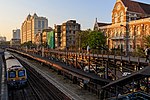India Tower
Proposed skyscrapers in IndiaResidential skyscrapers in MumbaiSkyscraper hotels in MumbaiUse Indian English from April 2017
India Tower (previously known as the Park Hyatt Tower; also known as the Dynamix Balwas Tower or DB Tower) is a canceled 126-story, 707.5 m (2,321 ft) megatall skyscraper that began construction in the city of Mumbai, India, in 2010. The tower was originally planned for completion in 2016, but construction work was put on hold in 2011 due to a dispute between the tower's developers and Mumbai's civic authorities.
Excerpt from the Wikipedia article India Tower (License: CC BY-SA 3.0, Authors).India Tower
Mumbai Kalbadevi (Zone 1)
Geographical coordinates (GPS) Address Nearby Places Show on map
Geographical coordinates (GPS)
| Latitude | Longitude |
|---|---|
| N 18.950159 ° | E 72.821348 ° |
Address
400020 Mumbai, Kalbadevi (Zone 1)
Maharashtra, India
Open on Google Maps






